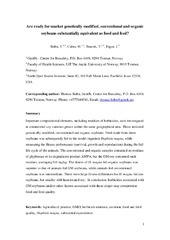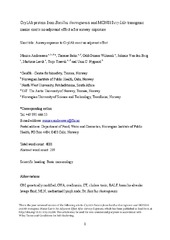Blar i forfatter Det helsevitenskapelige fakultet "Bøhn, Thomas"
-
Are ready for Market Genetically Modified, Conventional and Organic Soybeans Substantially Equivalent as Food and Feed?
Bøhn, Thomas; Cuhra, Marek; Traavik, Terje; Fagan, John (Chapter; Bokkapittel, 2015)Important compositional elements, including residues of herbicides, were investigated in commercial soy varieties grown within the same geographical area. These included genetically modified, conventional and organic soybeans. Feed made from these soybeans was subsequently fed to the model organism Daphnia magna, while measuring the fitness performance (survival, growth and reproduction) during the ... -
Assessing the probability of detection of horizontal gene transfer events in bacterial populations
Townsend, Jeffrey P.; Bøhn, Thomas; Nielsen, Kaare Magne (Journal article; Tidsskriftartikkel; Peer reviewed, 2012)Experimental approaches to identify horizontal gene transfer (HGT) events of non-mobile DNA in bacteria have typically relied on detection of the initial transformants or their immediate offspring. However, rare HGT events occurring in large and structured populations are unlikely to be detected in a short time frame. Population genetic modeling of the growth dynamics of bacterial genotypes is ... -
Chronic Responses of Daphnia magna under Dietary Exposure to Leaves of a Transgenic (Event MON810) Bt-Maize Hybrid and its Conventional Near-Isoline
Holderbaum, Daniel Ferreira; Cuhra, Marek; Wickson, Fern; Orth, Afonso Inácio; Nodari, Rubens Onofre; Bøhn, Thomas (Journal article; Tidsskriftartikkel; Peer reviewed, 2015-08-11)Insect resistance is the second most common trait globally in cultivated genetically modified (GM) plants. Resistance is usually obtained by introducing into the plant’s genome genes from the bacterium Bacillus thuringiensis (Bt) coding for insecticidal proteins (Cry proteins or toxins) that target insect pests. The aim of this study was to examine the hypothesis that a chronic, high-dose dietary ... -
Clone- and age-dependent toxicity of a glyphosate commercial formulation and its active ingredient in Daphnia magna.
Cuhra, Marek; Traavik, Terje; Bøhn, Thomas (Journal article; Tidsskriftartikkel; Peer reviewed, 2013)Low levels of glyphosate based herbicide induced significant negative effects on the aquatic invertebrate Daphnia magna. Glyphosate herbicides such as brands of Roundup, are known to be toxic to daphnids. However, published findings on acute toxicity show significant discrepancies and variation across several orders of magnitude. To test the acute effects of both glyphosate and a commercial ... -
Co-existence challenges in small-scale farming when farmers share and save seeds
Bøhn, Thomas; Aheto, Denis; Mwangala, Felix; Bones, Inger Louise; Simoloka, Christopher; Mbeule, Ireen; Wikmark, Odd Gunnar; Schmidt, Gunther; Chapela, Ignacio (Chapter; Bokkapittel, 2013)Gene flow by means of pollen and seeds in maize influences local, regional and global maize biodiversity. Developing countries are centers of diversity for maize and preserve seeds also in informal seed systems. Particularly in poor communities, seed saving and sharing often co-occur with farming on small fields. We present preliminary investigations from a small-scale maize farming community, in ... -
The competitive edge of an invading specialist
Bøhn, Thomas; Amundsen, Per-Arne (Journal article; Tidsskriftartikkel; Peer reviewed, 2001-08-01)Introduced species represent major threats to native and natural biodiversity. On the other hand, biologists may increase the understanding of ecological interactions by following communities during establishment of exotic species. Accordingly, feeding ecology and habitat use were studied in native whitefish (<i>Coregonus lavaretus</i>) and recently invading vendace (<i>C. albula</i>) in two lake ... -
Compositional differences in soybeans on the market: glyphosate accumulates in Roundup Ready GM soybeans
Bøhn, Thomas; Cuhra, Marek; Traavik, Terje; Sanden, Monica; Primicerio, Raul (Journal article; Tidsskriftartikkel; Peer reviewed, 2014)This article describes the nutrient and elemental composition, including residues of herbicides and pesticides, of 31 soybean batches from Iowa, USA. The soy samples were grouped into three different categories: (i) genetically modified, glyphosate-tolerant soy (GM-soy); (ii) unmodified soy cultivated using a conventional ‘‘chemical’’ cultivation regime; and (iii) unmodified soy cultivated using an ... -
Cry1Ab Protein from Bacillus thuringiensis and MON810 cry1Ab-transgenic Maize Exerts No Adjuvant Effect After Airway Exposure
Andreassen, Monica; Bøhn, Thomas; Wikmark, Odd Gunnar; van den Berg, Johnnie; Løvik, Martinus; Traavik, Terje; Nygaard, Unni Cecilie (Journal article; Tidsskriftartikkel; Peer reviewed, 2015-02-24)The genetically modified (GM) maize event MON810 has been inserted with a processed version of the transgene, cry1Ab, derived from the soil bacterium Bacillus thuringiensis (Bt) to express proteins with insecticidal properties. Such proteins may introduce new allergens and also act as adjuvants that promote allergic responses. While focus has been on safe consumption and hence the oral exposure to ... -
Detecting rare gene transfer events in bacterial populations
Nielsen, Kåre Magne; Bøhn, Thomas; Townsend, Jeffrey P. (Journal article; Tidsskriftartikkel; Peer reviewed, 2014) -
The German ban on GM maize MON810: scientifically justified or unjustified?
Bøhn, Thomas; Primicerio, Raul; Traavik, Terje (Journal article; Tidsskriftartikkel; Peer reviewed, 2012) -
Glyphosate-Residues in Roundup-Ready Soybean Impair Daphnia magna Life-Cycle
Cuhra, Marek; Traavik, Terje; Dando, Mickael; Primicerio, Raul; Holderbaum, Daniel Ferreira; Bøhn, Thomas (Journal article; Tidsskriftartikkel; Peer reviewed, 2015-01-30)Herbicide tolerant plants such as Roundup-Ready soybean contain residues of glyphosate herbicide. These residues are considered safe and previous animal-feeding-studies have failed to find negative effects related to such chemical residues. The present study tests 8 experimental soy- meal diets as feed in groups (each containing 20 individuals) of test-animals (D. magna). The diets have different ... -
Glyphosate: too much of a good thing?
Cuhra, Marek; Bøhn, Thomas; Cuhra, Petr (Journal article; Tidsskriftartikkel; Peer reviewed, 2016-04-28)Although previously accepted as the less toxic alternative, with low impact on animals, farmers as well as consumers who are exposed to residues in food, glyphosate chemicals are now increasingly controversial as new evidence from research is emerging. We argue that specific aspects of the history, chemistry and safety of glyphosate and glyphosate-based herbicides should be thoroughly considered ... -
Hazard Characterization of Modified Vaccinia Virus Ankara Vector: What Are the Knowledge Gaps?
Okeke, Malachy Ifeanyi; Okoli, Arinze Stanley; Diaz Canova, Diana Karina; Oludotun, Taiwo G.; Tryland, Morten; Bøhn, Thomas; Moens, Ugo (Journal article; Tidsskriftartikkel; Peer reviewed, 2017-10-29)Modified vaccinia virus Ankara (MVA) is the vector of choice for human and veterinary applications due to its strong safety profile and immunogenicity in vivo. The use of MVA and MVA-vectored vaccines against human and animal diseases must comply with regulatory requirements as they pertain to environmental risk assessment, particularly the characterization of potential adverse effects to humans, ... -
Helse- og miljørisikovurdering genmodifisert mais MON 87460 fra Monsanto (EFSA/GMO/NL/2009/70)
Sorteberg, Hilde-Gunn Opsahl; Bøhn, Thomas; Finne, Merethe Aasmo; Holck, Askild Lorentz; Klungland, Helge; Meadow, Richard; Mikalsen, Arne; Myhr, Anne Ingeborg; Nerland, Audun Helge; Nes, Ingolf; Nielsen, Kaare Magne; Stabbetorp, Odd Egil; Thrane, Vibeke; Vikse, Rose (Research report; Forskningsrapport, 2010-05-04)Helse- og miljørisikovurderingen av den maislinjen MON 87460 (EFSA/GMO/NL/2009/70) fra Monsanto er utført av Faggruppe for genmodifiserte organismer i Vitenskapskomiteen for mattrygghet (VKM). Mattilsynet og Direktoratet for naturforvalting (DN) ber Vitenskapskomiteen for mattrygghet om å vurdere den genmodifiserte maislinjen MON 87460 til import og prosessering, og til bruk ... -
Helse- og miljørisikovurdering av genmodifisert bomullslinje MON 15985 fra Monsanto (EFSA/GMO/UK/2008/57): Uttalelse fra Faggruppe for genmodifiserte organismer i Vitenskapskomiteen for mattrygghet
Berdal, Knut G; Bøhn, Thomas; Clarke, Jihong; Finne, Merethe Aasmo; Holck, Askild Lorentz; Klungland, Helge; Linnestad, Casper; Meadow, Richard; Mikalsen, Arne; Myhr, Anne Ingeborg; Nerland, Audun Helge; Nes, Ingolf; Nielsen, Kaare Magne; Sorteberg, Hilde-Gunn Opsahl; Stabbetorp, Odd Egil; Vikse, Rose (Research report; Forskningsrapport, 2008-11-28)<i>Hovedbudskap</i>: Mattilsynet og Direktoratet for naturforvalting (DN) ber Vitenskapskomiteen for mattrygghet om å vurdere den genmodifiserte bomullslinjen MON 15985 til import, prosessering, og til bruk i næringsmidler og fôrvarer. Søknaden gjelder ikke dyrking. Monsanto søkte opprinnelig om godkjenning av bomullslinjen i 2005, men søknaden ble trukket og erstattet av vedlagte søknad i 2008. I ... -
Helse- og miljørisikovurdering av genmodifisert mais GA21 Syngenta Seeds S.A.S. (EFSA/GMO/UK/2008/60. Uttalelse fra Faggruppe for genmodifiserte organismer i Vitenskapskomiteen for mattrygghet
Sorteberg, Hilde-Gunn Opsahl; Bøhn, Thomas; Finne, Merethe Aasmo; Holck, Askild Lorentz; Klungland, Helge; Mikalsen, Arne; Meadow, Richard; Myhr, Anne Ingeborg; Nerland, Audun Helge; Nes, Ingolf; Nielsen, Kaare Magne; Stabbetorp, Odd Egil; Vikse, Rose (Research report; Forskningsrapport, 2010-04-07)Helse- og miljørisikovurderingen av den herbicidtolerante maislinjen GA21 (EFSA/GMO/UK/2008/60) fra Syngenta Seeds S.A.S. er utført av Faggruppe for genmodifiserte organismer i Vitenskapskomiteen for mattrygghet (VKM). VKM er bedt av Mattilsynet og Direktoratet for naturforvalting (DN) om å vurdere helse- og miljørisiko ved en eventuell godkjenning av maislinje GA21 for alle bruksområder, inkludert ... -
Humoral and cellular immune responses in mice after airway administration of Bacillus thuringiensis Cry1Ab and MON810 cry1Ab-transgenic maize
Andreassen, Monica; Rocca, Elena; Bøhn, Thomas; Wikmark, Odd Gunnar; van den Berg, Johnnie; Løvik, Martinus; Traavik, Terje; Nygaard, Unni Cecilie (Journal article; Tidsskriftartikkel; Peer reviewed, 2014)Genetically modified (GM) crops may bring new proteins with immunogenic and allergenic properties into the food and feed chains. The most commonly grown GM maize, MON810, expresses a modified version of the insecticidal Cry1Ab protein originating in the soil bacterium Bacillus thuringiensis(Bt). Immune reactions following inhalation of pollen and debris from such plants have been scarcely studied. ... -
Implications of GM crops in subsistence-based agricultural systems in Africa
Aheto, Denis; Bøhn, Thomas; Breckling, Broder; van den Berg, Johnnie; Ching, Lim Li; Wikmark, Odd Gunnar (Chapter; Bokkapittel, 2013)<p>Africa has deep contentions on the use of GM crops in agriculture, similar to those found in Europe and elsewhere. However, it is apparent that the debate is most protracted on the continent with two entrenched viewpoints i.e. the pro-GMO and anti-GMO groups. The challenge for an acceptable consensus is attributable to a complexity of issues relative to the introduction of GM maize into small-scale ... -
In plastico: laboratory material newness affects growth and reproduction of Daphnia magna reared in 50-ml polypropylene tubes
Cuhra, Marek; Bøhn, Thomas; Cuhra, Petr (Journal article; Tidsskriftartikkel; Peer reviewed, 2017-04-20)Plastic laboratory materials are found to affect vital parameters of the waterflea Daphnia magna. The main responsible factor is defined as “newness” of the materials. Juvenile D. magna were raised individually in; a) new laboratory-standard 50 ml polypropylene tubes, and; b) identical tubes which had been washed and aerated for several weeks. Newness had significant effects on growth and fecundity ... -
Invasion-mediated changes in the population biology of a dimorphic whitefish Coregonus lavaretus population
Bøhn, Thomas; Amundsen, Per-Arne (Journal article; Tidsskriftartikkel; Peer reviewed, 2004-02-26)Population biology changes in native dimorphic whitefish <i>Coregonus lavaretus</i> were studied over a decade in the subarctic Pasvik watercourse, where large biotric changes occurred due to an invasion by vendace <i> C. albula</i>. Although initially recorded in the upstream part of the watercourse, where it is now the dominant pelagic species, the vendace subsequently also colonised the downstream ...


 English
English norsk
norsk


















